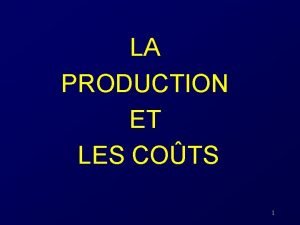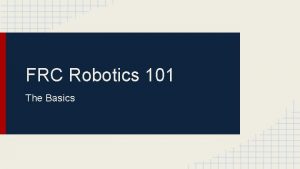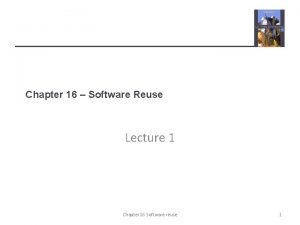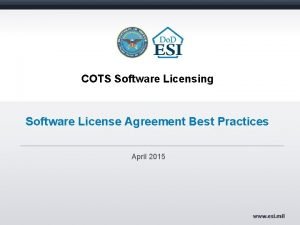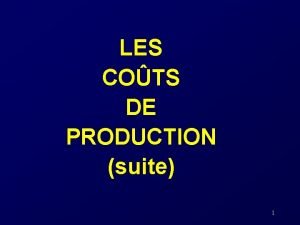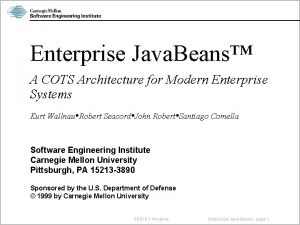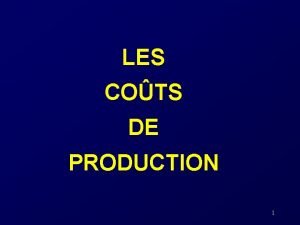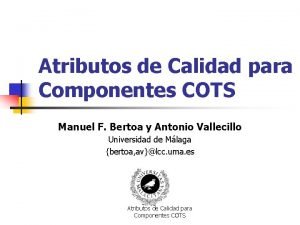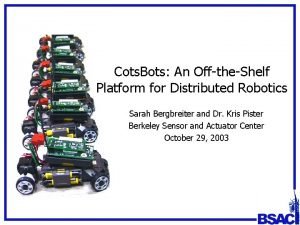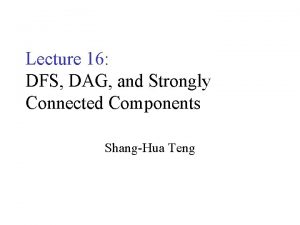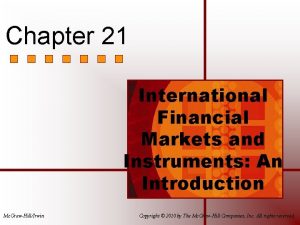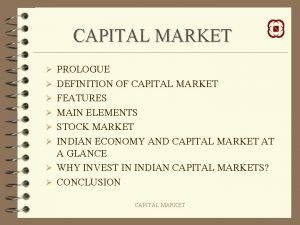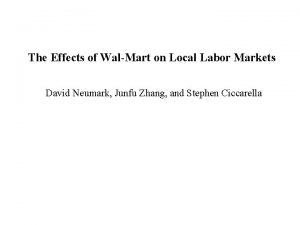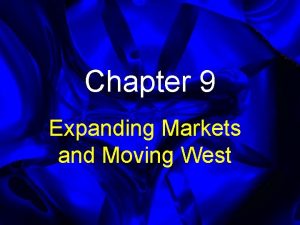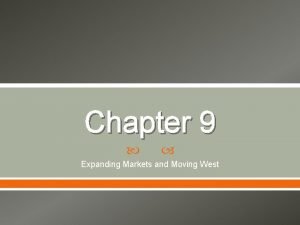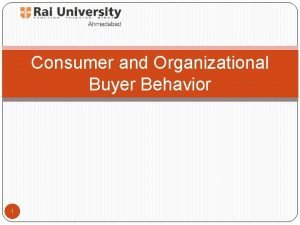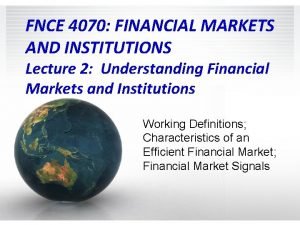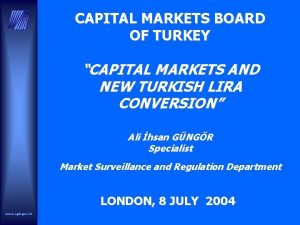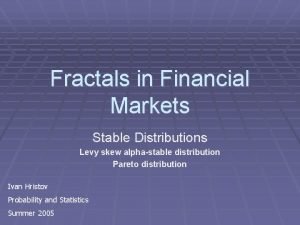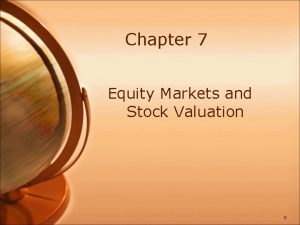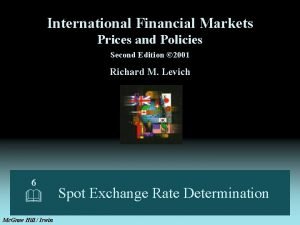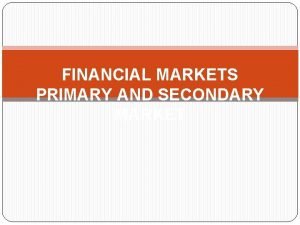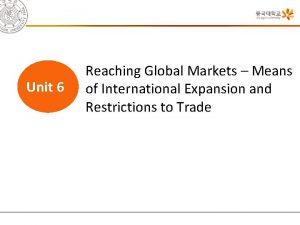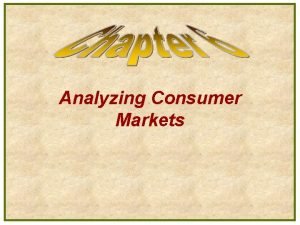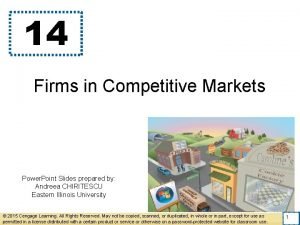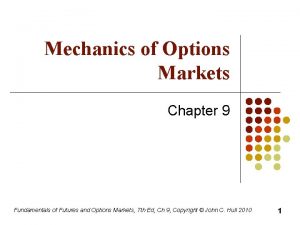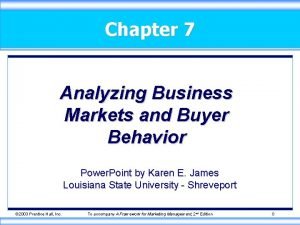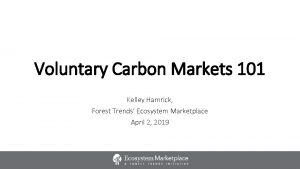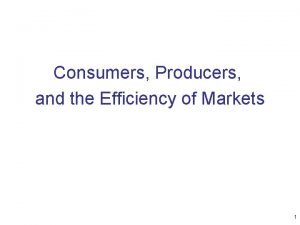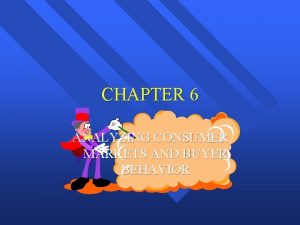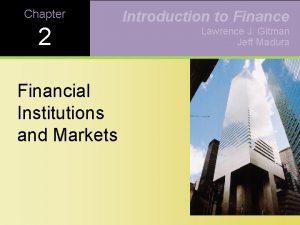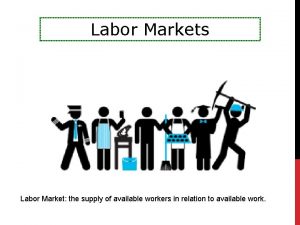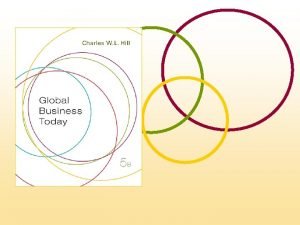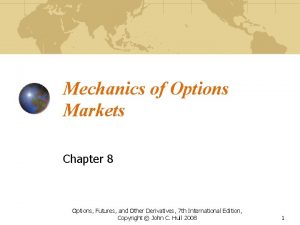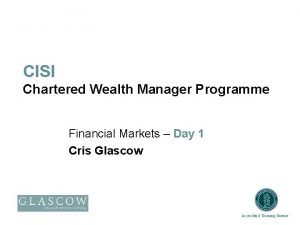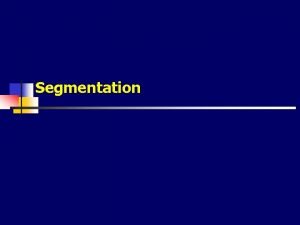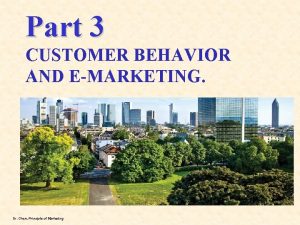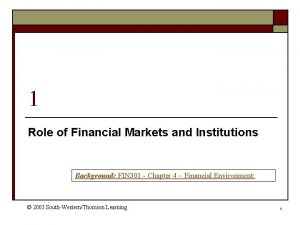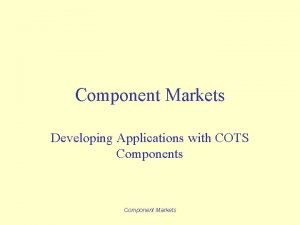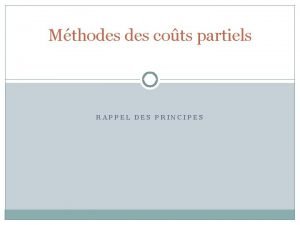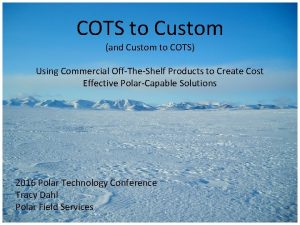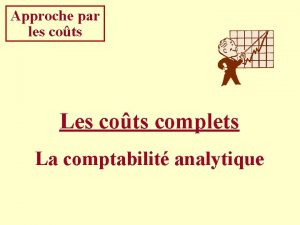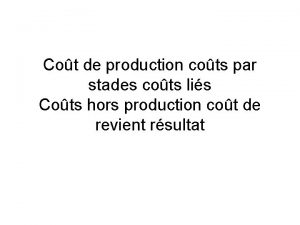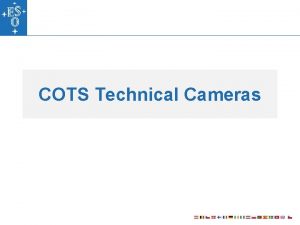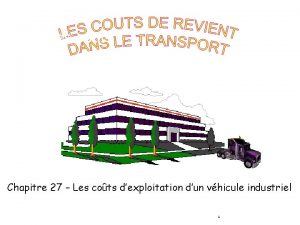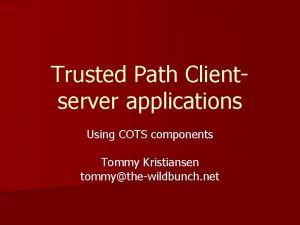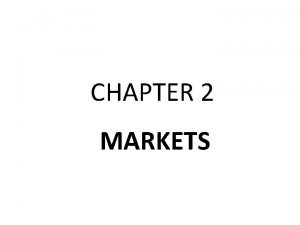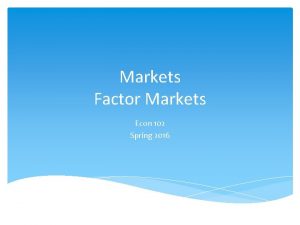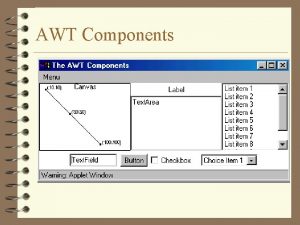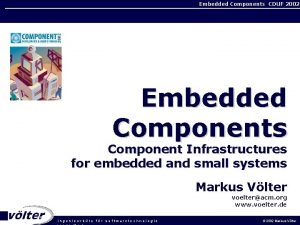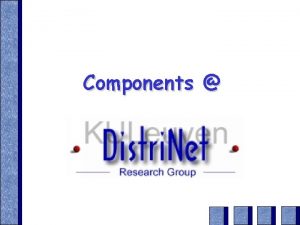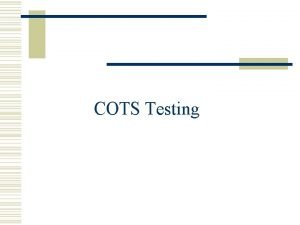Component Markets Developing Applications with COTS Components Component















































- Slides: 47

Component Markets Developing Applications with COTS Components Component Markets

Any Questions? Component Markets

Agenda 1. 2. 3. 4. 5. High-level overview of CBSD and COTS Case Study: When it works Potential Problems Case Study: When it doesn’t work How to make it work 1. Assessing Components 2. Component Qualities 3. Cost Estimation 11/29/2020 Component Markets 3

Component-Based Software Development: An Overview • The idea: Let’s make software like integrated circuits! Assemble, don’t build software! • Component: “A piece of software written with reuse in mind that can be deployed with little or no modification. ” -- Mancebo • Usually divided into – Black box components – White box components • Components have ‘weight’ 11/29/2020 Component Markets 4

CBSD: Promises • A component market will exist – Bringing economies of scale to the software world – Reduce development costs and time-to-market – Increased vendor specialization – Higher software quality • Standard components used to make custom software – Thus retaining individual competitive advantage 11/29/2020 Component Markets 5

Plug-and-play! Spreadsheet functions 11/29/2020 Component Markets 6

New Roles in the Component Market • Component System Architect – Ensures different frameworks can cooperate • Component Framework Architect – Ensures different components can cooperate • Component Developer – Develops component functionality • Component Assembler – Assembles applications from components 11/29/2020 Component Markets 7

The Technologies • Components need to communicate • Standards and technologies – OLE, Active. X, COM/COM+ – Java Beans, EJB – CORBA 11/29/2020 Component Markets 8

Current State of the Market • Numbers are soft, but it appears the market is on its way up – Initially, fine-grained GUI components – Now, more medium and large-grain server components • 54% of software projects used purchased code (2000) 11/29/2020 Component Markets 9

Case Study: When it Works… • Hubble Space Telescope Control Center Software was redone • Goals: – Use COTS to save money – Extend life of HST until 2010 • Mission-critical software – High performance requirements – High security requirements 11/29/2020 Component Markets 10

Case Study: When it Works… • Final Product – Integration of 30+ COTS/GOTS components with 1 M lines of legacy code using. 5 M lines of glue code • Results – Replaced 3 M lines of source code – Proof of concept delivered in 3 months – Live system delivered in 1 year – Brand new architecture delivers greater 11/29/2020 Component Markets functionality 11

CBSD: Perils • Components may provide more or less functionality than is needed • How do you know if a component performs as specified? – Testing black-box components can be difficult • Components don’t always work with other components or with existing code • The component market fluctuates greatly – Component lifecycles are short – No clear, established and trustworthy vendors 11/29/2020 Component Markets 12

Case Study: When it Doesn’t… • The Aesop Fable – An example of large-scale code reuse gone wrong • Summary – Even when existing components meet our needs, they may not fit well together 11/29/2020 Component Markets 13

For the Rest of the Lecture… • We’re going to talk about ways to avoid the perils of using commercial software components • This work is research in progress – Still no ‘perfect’ solution • Specific Techniques • General Guidelines 11/29/2020 Component Markets 14

The Development Process • Component Assessment • Component Tailoring • ‘Glue-code’ Development 11/29/2020 Component Markets 15

Principles to Adhere to 1. Process happens where effort happens 2. Don’t start with requirements 3. Avoid premature commitments, but have a plan 4. Buy information early to reduce risk 5. Prepare for COTS change 11/29/2020 Component Markets 16

Formal Component Evaluation (Lawlins et. Al) • “How do we select amongst many potential components? ” • Purchasing a COTS component is an investment • When the investment is significant… – Analysis should be done, on par with the analysis done for other investments – Traditionally, this analysis has been done in an adhoc manner 11/29/2020 Component Markets 17

Formal Component Evaluation • Uses weighted averages – (you have seen this before!) • Even uses controls. Components are evaluated: – By the same people – That have the same configuration – In the same scenarios – Using the same data 11/29/2020 Component Markets 18

Formal Component Evaluation • In general, component assessment is divided up into three stages 1. Trade Study: A ‘quick and dirty’ filtering of a large number of components 2. Hands-on Evaluation: A more thorough analysis of the remaining components 3. Final Selection: Selection based on the results of previous stages 11/29/2020 Component Markets 19

Formal Evaluation Process 11/29/2020 Component Markets 20

Trade Study • Break down your requirements – These will form the basis for questions on a questionnaire – Requirements should be of similar granularities – Send questionnaire to vendors and current users • Component Requirements Matrix • Components receiving half or more the possible points move on 11/29/2020 Component Markets 21

Components Requirements Matrix 11/29/2020 Component Markets 22

Hands-On Evaluation • You must actually have access to the components – Necessary if component represents a significant investment • Use components as the basis for tests – Scenario-Based Tests – Examining Specific Criteria 11/29/2020 Component Markets 23

Hands-On Evaluation 11/29/2020 Component Markets 24

Criticism of this Technique • This technique is primarily requirementsdriven – Tends to select “best-in-breed” components – Should be tailored to reflect internal requirements • Assumes clean division of requirements • Full assessment not always cost effective 11/29/2020 Component Markets 25

Component Selection: Revised • The previous technique selecting components was fundamentally requirements-based • Now you will see a technique for selecting components that is architecture based • Goal: – Avoid the problems encountered in “Architectural Mismatch” 11/29/2020 Component Markets 26

Architecture-Based COTS Selection • When using COTS, you accept their architectural restrictions • Component selection and architecture definition are intertwined • The following method treats them as such • Here we’ll use a simple case study to exemplify the points – Case study come from Mancebo 2005 11/29/2020 Component Markets 27

Architecture-Based COTS Selection • 4 step, iterative process • Here we will select components for a multimedia presentation application • Think “Powerpoint 3 D” Choose Architectural Decisions Model Component Market List Implementation Approaches Choose Best Implementation Approach 11/29/2020 Component Markets 28

Architecture-Based COTS Selection • • Possible architectures are modeled as a decisions space Examples: 1. Should graphics object know how to render themselves (KAD 1 a), or should they be decoupled from rendering (KAD 1 b)? 2. Should objects keep track of time individually (KAD 2 a), or should their be master synchronization object (KAD 2 b)? 3. Should presentations be stored in XML format (KAD 3 a) or as serialized objects (KAD 3 b) ? 11/29/2020 Component Markets Choose Architectural Decisions Model Component Market List Implementation Approaches Choose Best Implementation Approach 29

Architecture-Based COTS Selection • • Perform analysis of available components Create matrices reflecting the assumptions a capabilities of components 1. Requirements fulfillment 2. Component dependency 3. Architectural Assumptions 11/29/2020 Component Markets Choose Architectural Decisions Model Component Market List Implementation Approaches Choose Best Implementation Approach 30

Requirements Fulfillment Ogre Direct. X Open. GL Graphics API X X Audio X 3 d Text X Scene Mgmt. Open. AL QT X X X GUI Widgets 11/29/2020 OGLFT X Component Markets 31

Component Dependency & Architectural Assumptions Graphics API Ogre MFC Open. GL Ogre X KAD 1 Direct. X 1 a X KAD 3 OGLFT X GLTT X 11/29/2020 KAD 2 Component Markets 32

Architecture-Based COTS Selection • • To determine the feasible selections: Enumerate the architectural approaches – Of the form: – Example: • Choose Architectural Decisions Model Component Market Enumerate implementation approaches • • List Implementation Approaches Of the form: Example: Choose Best Implementation Approach 11/29/2020 Component Markets 33

Architecture-Based COTS Selection • Under the constraints that this set of components: 1. Covers all rows in the requirements matrix 2. Satisfies all component dependencies 3. Is consistent with Architectural Approach 11/29/2020 Component Markets Choose Architectural Decisions Model Component Market List Implementation Approaches Choose Best Implementation Approach 34

Architecture-Based COTS Selection • • • After all of this, you’ll come up with several feasible permutations. These permutations are evaluated on the basis of Architecture and Implementation together. Example: – Portability is a high priority so you lean towards implementations that don’t require Direct. X or MFC. 11/29/2020 Component Markets Choose Architectural Decisions Model Component Market List Implementation Approaches Choose Best Implementation Approach 35

Component Quality • Quality Characteristics – Dimensions of software quality • Quality Attributes – Specific information about components that will help you determine the characteristics • Here we will cover Characteristics and Attributes specific to COTS components 11/29/2020 Component Markets 36

Where does this come from? • ISO 9126 defines Quality Characteristics • This is a proposed modification to the specification • Modified to recognized specifically what defines quality in COTS components 11/29/2020 Component Markets 37

Reliability: Maturity • We would like to use stable components. • Maturity can be measured in: – Volatility: The mean time between versions – Evolve-ability: The number of versions – Failure Removal: The bugs fixed in the current component 11/29/2020 Component Markets 38

Usability: Learn-ability • Note the difference in perspective here – Developer’s not end-user’s usability • Can be measured with – Time to use – Time to configure – Time to admin – Time to master 11/29/2020 Component Markets 39

Usability: Understand-ability • Closely related to Learn-ability • Can be measured in the quality of: – Human-readable documentation – Help System – Machine-readable documentation – Training Provided – Demo-ed functionality 11/29/2020 Component Markets 40

Maintain-ability: Change-ability • Different from the traditional idea of maintainability • Can be measured in: – Customizability: Number of customizable parameters – Customizability Ratio: Parameters / Interfaces – Change Control Capability: Difficulty of identifying component versions 11/29/2020 Component Markets 41

Maintain-ability: Testability • Can the proper functionality of this component be tested easily? • Can be measured in: – POST: Does component perform environment test? – Test suite: Is a test suite provided? – Testable interfaces: Do interfaces allow for easy testing? 11/29/2020 Component Markets 42

Cost Estimation • • • Most of you are familiar with COCOMO COCOTS is an extension to COCOMO for COTS-based projects Four sources of cost (In order of cost): 1. 2. 3. 4. 11/29/2020 Glue-Code Development Tailoring Volatility Assessment Component Markets 43

COCOTS • Assessment • Glue Code • Tailoring • Volatility 11/29/2020 Component Markets 44

Unknowns • Pricing model? – Pay-per-use? Licensing fees? One time cost? • Legal issues? – Who holds liability? • Current Processes and Metrics are insufficient 11/29/2020 Component Markets 45

Any Questions? Component Markets

1. References Abts, C. Boehm, B. Clark, E. B. 5. Lawlis, P. K. Mark, K. E. Thomas, D. A. “COCOTS: A COTS Software Courtheyn, T. , “A formal process for Integration Lifecycle Cost Model evaluating COTS software products, ” Model Overview and Preliminary Data Computer, vol. 34, no. 5 pp. 58 -63, May 2001. Collection Findings. ” USC CSE 6. Mancebo, E. and Andrews, A. 2005. A Technical Report , USC-CSE-2000 -501. strategy for selecting multiple components. In 2. L. Bass, C. Buhman, S. Comella-Dorda, Proceedings of the 2005 ACM Symposium on F. Long, J. Robert, R. Seacord, and K. Applied Computing (Santa Fe, New Mexico, Wallnau, “Volume I: Market March 13 - 17, 2005). L. M. Leibrock, Ed. Assessment of Component-Based SAC '05. ACM Press, New York, NY, 1505 Software Engineering, ” Software 1510. Engineering Institute, Technical Note 7. Pfarr, T. and Reis, J. E. 2002. The Integration CMU/SEI-2001 -TN-007, May, 2000 of COTS/GOTS within NASA's HST 2001. Command Control System. In 3. Bertoa, M. and Vallecillo, A. Quality Proceedings of the First international Attributes for COTS Components. In Conference on Cots-Based Software Systems th Proceedings of QAOOSE 02, the 6 (February 04 - 06, 2002). J. C. Dean and A. International Workshop on Quantitative Gravel, Eds. Lecture Notes In Computer Approaches in Object-Oriented Software Science, vol. 2255. Springer-Verlag, London, Engineering (Malaga, Spain, 2002). 209 -221. 4. David Garlan, Robert Allen, and John 8. Vitharana, P. 2003. Risks and challenges of Ockerbloom. Architectural Mismatch or component-based software development. Why it’s hard to build systems out of Commun. ACM 46, 8 (Aug. 2003), 67 -72. existing parts. In Proceedings of the 9. Y. Yang, J. Bhuta, B. Boehm, and D. N. Port. Seventeenth International Conference on “Value-Based Processes for COTS-Based Software Engineering, Seattle WA, April Applications. ” IEEE Software Vol 22 No. 4, 11/29/2020 Component Markets 47 1995. pp. 54 -62. July 2005.
 Les cots
Les cots Frc robot parts
Frc robot parts Cots etl
Cots etl Derek schatz
Derek schatz Cots reuse
Cots reuse Software licensing best practices
Software licensing best practices Les cots
Les cots Cots architecture
Cots architecture Cots informatique
Cots informatique Isocout
Isocout Componentes cots
Componentes cots Cots bot
Cots bot Strongly connected components applications
Strongly connected components applications International financial markets and instruments
International financial markets and instruments Features of capital market
Features of capital market Contrasting international markets
Contrasting international markets The effects of walmart on local labor markets
The effects of walmart on local labor markets Chapter 9 expanding markets and moving west
Chapter 9 expanding markets and moving west Chapter 9 expanding markets and moving west
Chapter 9 expanding markets and moving west Organizational buying behaviour
Organizational buying behaviour Classification of financial markets
Classification of financial markets Pricing of securities in stock exchange
Pricing of securities in stock exchange Fractals in financial markets
Fractals in financial markets Chapter 18 the markets for the factors of production
Chapter 18 the markets for the factors of production Equity markets and stock valuation
Equity markets and stock valuation Encirclement attack examples
Encirclement attack examples Sociology major dartmouth
Sociology major dartmouth Levich international financial markets
Levich international financial markets How do primary and secondary financial markets differ
How do primary and secondary financial markets differ Reaching global markets
Reaching global markets Analyzing consumer markets
Analyzing consumer markets Firms in competitive markets chapter 14 ppt
Firms in competitive markets chapter 14 ppt Mechanics of options markets
Mechanics of options markets Business markets and business buyer behavior ppt
Business markets and business buyer behavior ppt Gramin agricultural markets
Gramin agricultural markets Why study money banking and financial markets
Why study money banking and financial markets Un emissions gap report
Un emissions gap report Consumers producers and the efficiency of markets
Consumers producers and the efficiency of markets Analyzing consumer markets
Analyzing consumer markets Madura j. financial markets and institutions
Madura j. financial markets and institutions Labor market
Labor market When entering foreign markets basic entry
When entering foreign markets basic entry Nomura connecting markets east & west
Nomura connecting markets east & west Mechanics of options
Mechanics of options Cisi financial markets
Cisi financial markets Heterogent marked
Heterogent marked Reseller markets consist mainly of
Reseller markets consist mainly of Role of financial markets
Role of financial markets
